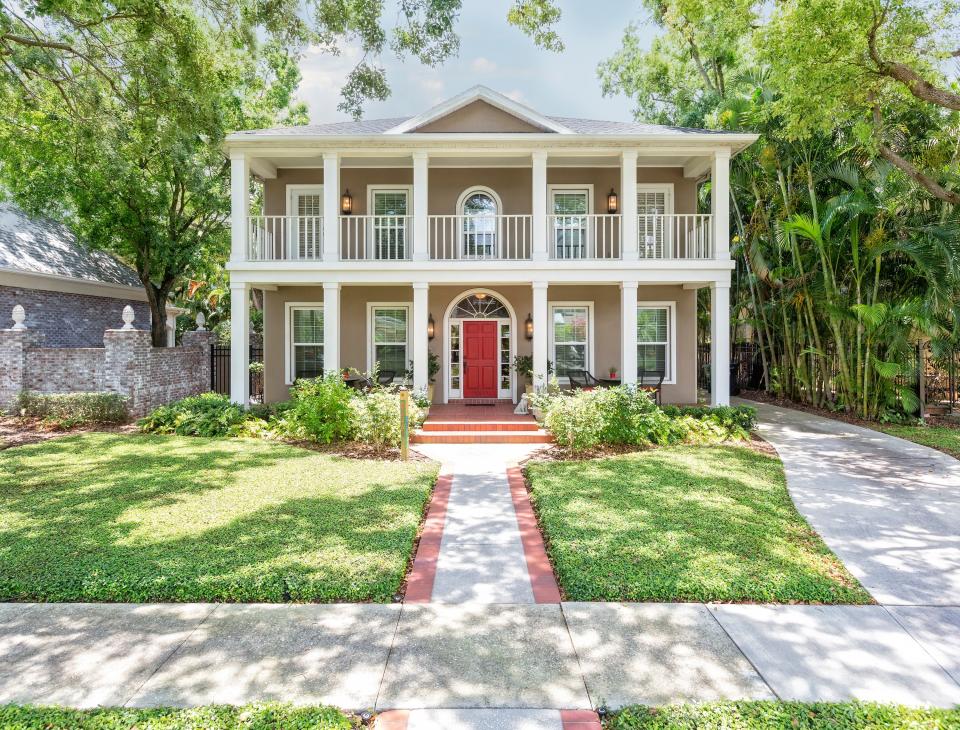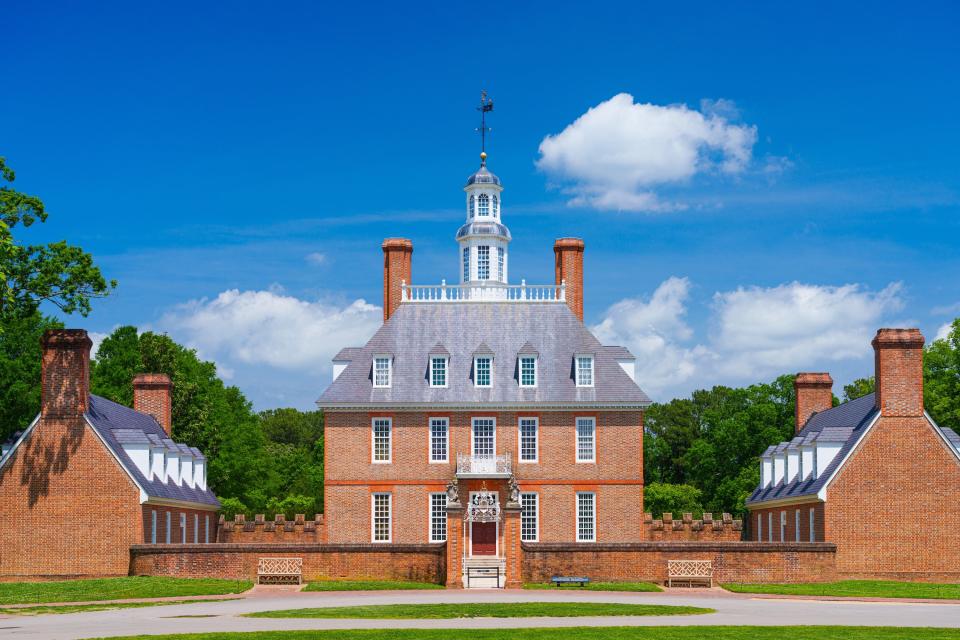Colonial Architecture: Everything You Need to Know

Photo: Getty Images
The term colonial architecture broadly refers to the buildings and homes that were constructed during a period of colonization in a given country. American colonial architecture emerged in the United States when Northern European settlers established colonies here in the 17th and 18th centuries. “They adapt[ed] their architectural styles to local conditions, materials, and cultural influences,” says Alan Clark of Alan Clark Architects in Atlanta.
Recognizable for their symmetry, rectangular shape, and sash windows, colonial houses define many of the oldest neighborhoods in the US. These historic areas are clustered along the East Coast, where the original 13 colonies once were, but colonial-style homes can be found all over the country, thanks to the colonial revival boom of the late 1800s and early 1900s. Colonial might just be America’s most iconic architectural style—which is one of many reasons you should learn more about it.
Here’s everything you need to know about colonial architecture.
What is the history of colonial architecture?
The earliest examples of colonial architecture in the US date back to 1626 and were simple one-story buildings with gabled roofs and few rooms, says Craig Intinarelli of Kroeger Intinarelli Architects in Katonah, New York. “These first domestic structures were almost medieval due to their transient nature,” he adds. “The principal materials of these early colonial archetypes were wood due to the abundance of forests and the immediate necessity to establish a safe haven in the new world.”
As resources became more accessible, living conditions improved and thus the classic colonial architecture style was born. “The European influence on Mid-Atlantic and New England colonial architecture would continue as grander homes developed,” says Intinarelli. “Much would come from British and French interpretations of antiquity found in Roman and Greek architecture. Homes would also be influenced by traditional pattern books from Europe illustrating the use of profiled moldings, paneled walls, and millwork.”

Regional Luxury Houses
Photo: Getty Images/Terry J. AlcornAccording to Intinarelli, “the strongest influence came from the American gentry’s embrace of the works of Andrea Palladio and the French neoclassicists. Elements of the colonial style would include a strong central axis where the front door was placed, symmetrical plans with columnar, temple-like porticos, and decorative cornices and architraves.”
Starting in the late 19th century, colonial-style architecture saw a resurgence. Such homes are aptly called colonial revival. “Colonial architecture is officially on the east coast in the original colonies—hence its name, but the elements are repeated and still used today all over,” says Maren Baker of Maren Baker Design. “I live in Boise in a colonial revival house built in 1925.”
What are the defining elements and characteristics of colonial architecture?
External features
Symmetry
Rectangular shape
Two stories
Wood, brick, or stone facade
Central door
Columns
Porches
Gable roofs
Multi-paned sash windows
Dormer windows
Shutters
Chimneys
Internal features
Traditional, closed-off floor plan
Formal entryway
Big, central staircase
Long hallways
Living spaces, like the kitchen and dining room, on the main level
Bedrooms on the second level
Evenly-divided rooms
What are the different styles of colonial architecture?
British colonial

Governor's Palace of Colonial Williamsburg
Photo: Getty Images/Sean PavoneAs its name suggests, British colonial architecture is a result of English colonization in the US, from Massachusetts to Virginia and beyond. “It often combines Georgian and Victorian elements with symmetrical facades, sash windows, and decorative details,” shares Clark. Classical Greek and Roman influences, like pilasters and columns, were also common.
Dutch colonial
Dutch colonial architecture “features gambrel roofs, dormer windows, flared eaves, and a central chimney,” says Clark. “It’s primarily found in former Dutch colonies like Indonesia, South Africa, and parts of the United States, like New York and New Jersey.” Dutch colonial houses are known to resemble barns.
French colonial
Louisiana is home to the majority of America’s French colonial architecture, which is distinguished by “elements like steeply pitched roofs, large verandas, and French-inspired detailing,” Clark notes. The big, wraparound porches he mentions are often on both levels of the home, which may also have tall, narrow windows and French double doors.
Saltbox
According to Clark, Saltbox is a “style originating in New England, featuring asymmetrical rooflines with long, pitched roofs in the back and shorter roofs in the front.” Saltbox homes were built by settlers using local timber and got their name from their “resemblance to wooden lidded boxes in which salt was once kept.”
Southern colonial
Southern colonial architecture is native to the southeastern US and often includes “large verandas, tall windows, and grand, plantation-style designs,” Clark says. Colonnades tend to extend across the facades, while ornate moldings cover the interiors. Southern colonial homes are frequently set back from the main roads and accessed by long driveways.
Spanish colonial

Jackson Square at Twilight
Photo: Getty Images/Rebecca Elise Dunn-LevertThe rustic aesthetic of Spanish colonial architecture is “characterized by thick adobe walls, courtyards, and ornate detailing influenced by Spanish and Moorish architecture,” Clark explains. Red clay roof tiles and wooden beams are also typical. Spanish colonial houses and their derivatives are ubiquitous in Florida, the Southwest, and California.
What are the advantages and disadvantages of colonial architecture?
Advantages
Clark, Intinarelli, and Baker all agree that one of the biggest advantages of colonial architecture is its classic, timeless aesthetic that’s rooted in symmetry. “It can result in some really beautiful curb appeal,” Baker considers. “[Colonial homes] are classics in that they don’t really go out of style. The elements have been used for so long that you can feel safe in knowing you won’t be staring at a house that was so clearly made in a bad architecture period.”
Historic charm, sturdy construction, and sensible layout are among the other perks of living in a colonial house. “Many of our clients take on these homes out of passion for their history, patina, richness of material, and antique scale,” says Intinarelli. Clark adds, “Many colonial homes were built with durable materials—brick, stone, timber frame—and true craftsmanship, offering longevity.” And Baker notes, “I find this style of home to make sense—you aren’t left searching around for where the bathroom is because they are laid out in an orderly fashion.”
Disadvantages
For Baker, the biggest disadvantage of colonial architecture is its small scale. “If you live in a home from the late 1700s or 1800s that would be considered colonial, I would say the biggest con would be ceiling height and overall size,” she opines. “The homes were obviously much smaller than they are now. Ceilings were low, which can cause issues with HVAC systems and lighting options. Kitchens were also small and not very well located in the home. If you are looking for an open floor plan and large kitchen, you are not going to find that in a colonial home.”
Meanwhile, Clark and Intinarelli cite energy inefficiency, i.e. the lack of modern insulation and the presence of old windows, which can lead to higher utility costs, break modern energy codes, and be challenging to remedy, as a major downside. “Some of the pitfalls of restoring and modifying Colonial homes of a certain vintage is balancing the historic detailing and current energy code requirements, specifically, the rehabilitation versus installing of new windows and doors,” Intinarelli explains. Additionally, “older colonial homes may require more maintenance and upkeep, especially in terms of preserving historic features,” Clark says.
Originally Appeared on Architectural Digest

